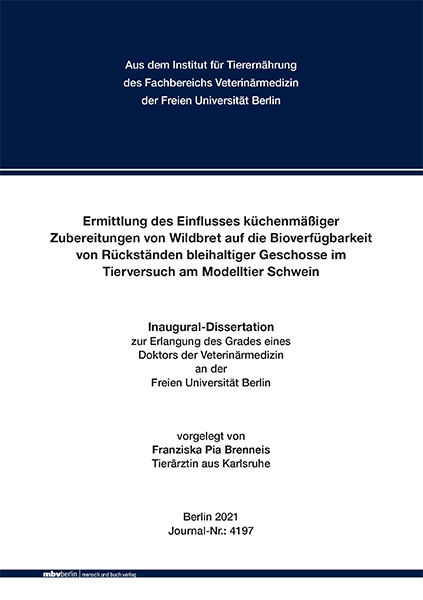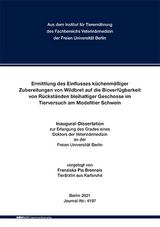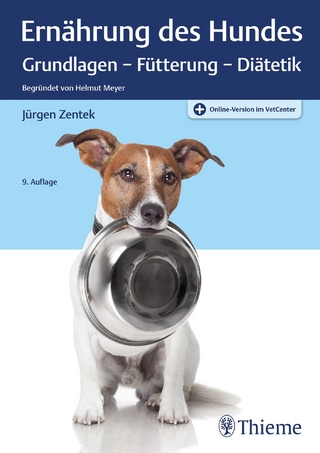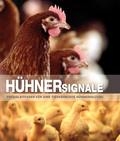Ermittlung des Einflusses küchenmäßiger Zubereitungen von Wildbret auf die Bioverfügbarkeit von Rückständen bleihaltiger Geschosse im Tierversuch am Modelltier Schwein
Seiten
2021
|
1. Aufl.
Mensch & Buch (Verlag)
978-3-96729-107-0 (ISBN)
Mensch & Buch (Verlag)
978-3-96729-107-0 (ISBN)
- Keine Verlagsinformationen verfügbar
- Artikel merken
Die Zielsetzung der vorliegenden Studie war die Untersuchung der Beeinflussung der Bioverfügbarkeit von Blei durch die küchenmäßige Zubereitung von Wildbret, welches mit bleihaltiger Munition erlegt worden war. Die Nullhypothese dieser Arbeit lautet, dass sich die Veränderung der Bleikonzentrationen im Blut zwischen den Versuchsgruppen und der Kontrollgruppe nicht unterscheidet. Dazu wurde in einem Fütterungsversuch mit Schweinen einmalig eine Wildbretportion verfüttert, die von Rehen stammte, die mit bleihaltiger Munition erlegt worden waren. Versuchsgruppe A (sieben Tiere) erhielt eine Wildbretportion, die lediglich gebraten worden war. Diese Versuchsgruppe nahm eine Bleimenge von ca. 0,77 mg auf. Versuchsgruppe B (sieben Tiere) erhielt eine gebratene und gebeizte Wildbretportion und nahm eine Bleimenge von ca. 0,65 mg auf. Eine Kontrollgruppe (vier Tiere) erhielt eine gebratene und gebeizte Wildbretportion, welche von Rehen stammte, die mit bleifreier Munition erlegt worden waren. Die im weiteren Verlauf des Versuchs durchgeführten Blutentnahmen zeigten, dass die Bleikonzentration im Blut der Tiere in Versuchsgruppe B relativ zu Versuchsgruppe A für die auf die Fütterung folgenden drei Tage stärker anstieg. Versuchsgruppe A zeigte an Tag 1 eine Bleikonzentration im Blut von 3,02 μg/l, an Tag 2 von 2,77 μg/l und an Tag 3 von 2,20 μg/l. Bei Versuchsgruppe B lagen die Bleikonzentrationen im Blut bei 3,12 μg/l an Tag 1, 10,57 μg/l an Tag 2 und 7,29 μg/l an Tag 3. Versuchsgruppe B wies relativ zu Versuchsgruppe A für die Tage 1, 2 und 3 signifikant stärkere Zunahmen der Bleikonzentration im Blut auf. Für die Tage 1 und 2 wies Versuchsgruppe B relativ zur Kontrollgruppe K signifikant höhere Zunahmen der Bleikonzentration im Blut auf. Am Tag 0 stieg die Bleikonzentration im Blut der Tiere in Versuchsgruppe B im Vergleich zu Tag -1 signifikant stärker an als bei der Versuchsgruppe A und der Kontrollgruppe. Somit konnte die Alternativhypothese, dass sich die Veränderung der Bleikonzentrationen im Blut zwischen den Gruppen unterscheidet, bewiesen werden.
Der im Rahmen dieser Studie durchgeführte Fütterungsversuch zeigt, dass die küchenmäßige Zubereitung einen signifikanten Einfluss auf den Anstieg der Bleikonzentration im Blut der Schweine hatte. Durch die Zubereitung mit einer sauren Beize stieg die bioverfügbare Bleimenge an und es ist davon auszugehen, dass für den Verbraucher durch den Verzehr einer solchen Wildbretzubereitung die Exposition gegenüber Blei zunimmt. Die Bioverfügbarkeit von Blei in Wildbret nach Beizen und Braten lag im vorliegenden Versuch bei 15,0 % im Vergleich zu 1,3 %, wenn das Wildbret nur gebraten wurde. Investigation of the impact of the food preparation and cooking process of game meat on the bioavailability of residues of lead-containing ammunition in an animal experiment with pigs
The main objective of this study was to reveal the impact of the food preparation and cooking process on the bioavailability of lead in game meat. The null hypothesis of this study says that there is no difference in the change in the blood lead concentrations between the study groups and the control group. In this study a feeding trial was conducted, in which pigs were fed once with roe deer meat, which had been shot using lead-containing ammunition. Study group A (7 pigs) received a fried game meat serving and had a lead intake of about 0.77 mg. Study group B (7 pigs) received a marinated and fried wild game meat serving and had a lead intake of about 0.65 mg. The control group (4 pigs) received marinated and fried wild game meat, which had been shot using lead-free ammunition. Several subsequently performed blood collections demonstrated that the blood lead concentrations of the pigs in study group B were relatively higher compared to study group A for each of the three days following the wild game meat serving. Study group A showed blood lead concentrations of 3.02 μg/l at day 1, 2.77 μg/l at day 2 und 2.20 μg/l at day 3. Study group B had blood lead concentrations of 3.12 μg/l at day 1, 10.57 μg/l at day 2 and 7.29 μg/l at day 3. Study group B showed for the days 1, 2 and 3 a significantly higher increase of the lead concentration relatively to study group A. Study group A received on trial day 0 a wild game meat serving which was only fried and not marinated. For the days 1 and 2, the study group B showed significantly higher increases in the blood lead concentration relatively to the control group K. Compared to the groups A and K, the blood lead concentration of the animals in study group B increased significantly from day -1 to 0. Consequently, the alternative hypothesis, which says that the change of the blood lead concentration between the groups is different, has been proven.
This feeding trial shows that the preparation and cooking process has a significant influence on the blood lead concentrations of the pigs. The way of preparing and cooking can increase the bioavailable lead amount in the meat. Regarding the consumer, it can be assumed that the exposition to lead increases through consumption of such wild game meat servings. In this study the bioavailability of lead in wild game meat after marinating and frying was 15.0 % compared to 1.3 % after frying only.
Der im Rahmen dieser Studie durchgeführte Fütterungsversuch zeigt, dass die küchenmäßige Zubereitung einen signifikanten Einfluss auf den Anstieg der Bleikonzentration im Blut der Schweine hatte. Durch die Zubereitung mit einer sauren Beize stieg die bioverfügbare Bleimenge an und es ist davon auszugehen, dass für den Verbraucher durch den Verzehr einer solchen Wildbretzubereitung die Exposition gegenüber Blei zunimmt. Die Bioverfügbarkeit von Blei in Wildbret nach Beizen und Braten lag im vorliegenden Versuch bei 15,0 % im Vergleich zu 1,3 %, wenn das Wildbret nur gebraten wurde. Investigation of the impact of the food preparation and cooking process of game meat on the bioavailability of residues of lead-containing ammunition in an animal experiment with pigs
The main objective of this study was to reveal the impact of the food preparation and cooking process on the bioavailability of lead in game meat. The null hypothesis of this study says that there is no difference in the change in the blood lead concentrations between the study groups and the control group. In this study a feeding trial was conducted, in which pigs were fed once with roe deer meat, which had been shot using lead-containing ammunition. Study group A (7 pigs) received a fried game meat serving and had a lead intake of about 0.77 mg. Study group B (7 pigs) received a marinated and fried wild game meat serving and had a lead intake of about 0.65 mg. The control group (4 pigs) received marinated and fried wild game meat, which had been shot using lead-free ammunition. Several subsequently performed blood collections demonstrated that the blood lead concentrations of the pigs in study group B were relatively higher compared to study group A for each of the three days following the wild game meat serving. Study group A showed blood lead concentrations of 3.02 μg/l at day 1, 2.77 μg/l at day 2 und 2.20 μg/l at day 3. Study group B had blood lead concentrations of 3.12 μg/l at day 1, 10.57 μg/l at day 2 and 7.29 μg/l at day 3. Study group B showed for the days 1, 2 and 3 a significantly higher increase of the lead concentration relatively to study group A. Study group A received on trial day 0 a wild game meat serving which was only fried and not marinated. For the days 1 and 2, the study group B showed significantly higher increases in the blood lead concentration relatively to the control group K. Compared to the groups A and K, the blood lead concentration of the animals in study group B increased significantly from day -1 to 0. Consequently, the alternative hypothesis, which says that the change of the blood lead concentration between the groups is different, has been proven.
This feeding trial shows that the preparation and cooking process has a significant influence on the blood lead concentrations of the pigs. The way of preparing and cooking can increase the bioavailable lead amount in the meat. Regarding the consumer, it can be assumed that the exposition to lead increases through consumption of such wild game meat servings. In this study the bioavailability of lead in wild game meat after marinating and frying was 15.0 % compared to 1.3 % after frying only.
| Erscheinungsdatum | 23.09.2021 |
|---|---|
| Verlagsort | Berlin |
| Sprache | deutsch |
| Maße | 148 x 210 mm |
| Gewicht | 300 g |
| Themenwelt | Veterinärmedizin ► Allgemein ► Tierernährung / Tierhaltung / Tierzucht |
| Veterinärmedizin ► Großtier ► Schwein | |
| Schlagworte | Animal model • Bioavailability • Bioverfügbarkeit • Blei • Bleivergiftung • Feeding • Fleisch • Food Hygiene • Food Safety • Fütterung • game animals • Hunting • Jagd • lead • lead poisoning • Lebensmittelhygiene • Lebensmittelsicherheit • meat • Pigs • Schweine • Tiermodell • Wildtiere |
| ISBN-10 | 3-96729-107-3 / 3967291073 |
| ISBN-13 | 978-3-96729-107-0 / 9783967291070 |
| Zustand | Neuware |
| Informationen gemäß Produktsicherheitsverordnung (GPSR) | |
| Haben Sie eine Frage zum Produkt? |
Mehr entdecken
aus dem Bereich
aus dem Bereich
Grundlagen - Fütterung - Diätetik Begründet von Helmut Meyer
Buch (2022)
Thieme (Verlag)
91,00 €
Praxisleitfaden für eine tiergerechte Hühnerhaltung
Buch | Softcover (2023)
Landwirtschaftsverlag Münster
44,80 €




